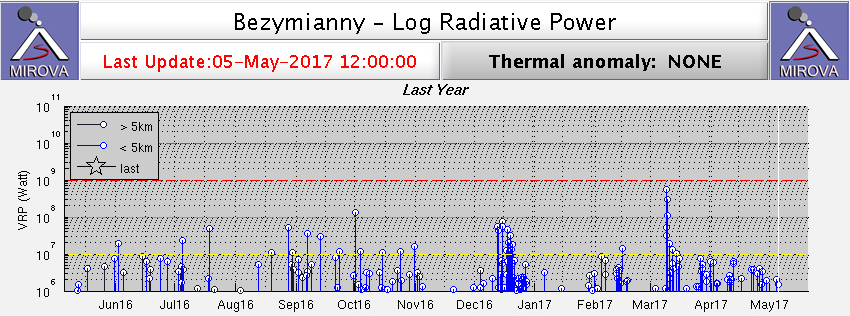Report on Bezymianny (Russia) — June 2017
Bulletin of the Global Volcanism Network, vol. 42, no. 6 (June 2017)
Managing Editor: Edward Venzke.
Research and preparation by Paul Berger.
Bezymianny (Russia) Lava dome extrusion December 2016-April 2017; large ash explosion on 9 March 2017
Please cite this report as:
Global Volcanism Program, 2017. Report on Bezymianny (Russia) (Venzke, E., ed.). Bulletin of the Global Volcanism Network, 42:6. Smithsonian Institution. https://doi.org/10.5479/si.GVP.BGVN201706-300250
Bezymianny
Russia
55.972°N, 160.595°E; summit elev. 2882 m
All times are local (unless otherwise noted)
The Kamchatka Volcanic Eruptions Response Team (KVERT) characterized Bezymianny as having weak activity from mid-June 2014 through the end of 2015, including weak or moderate gas-and-steam emissions (figures 17 and 18) and, when not obscured by clouds, weak thermal anomalies (BGVN 41:01). Observations here through May 2017 come from KVERT reports and Tokyo Volcanic Ash Advisory Center (VAAC) advisories.
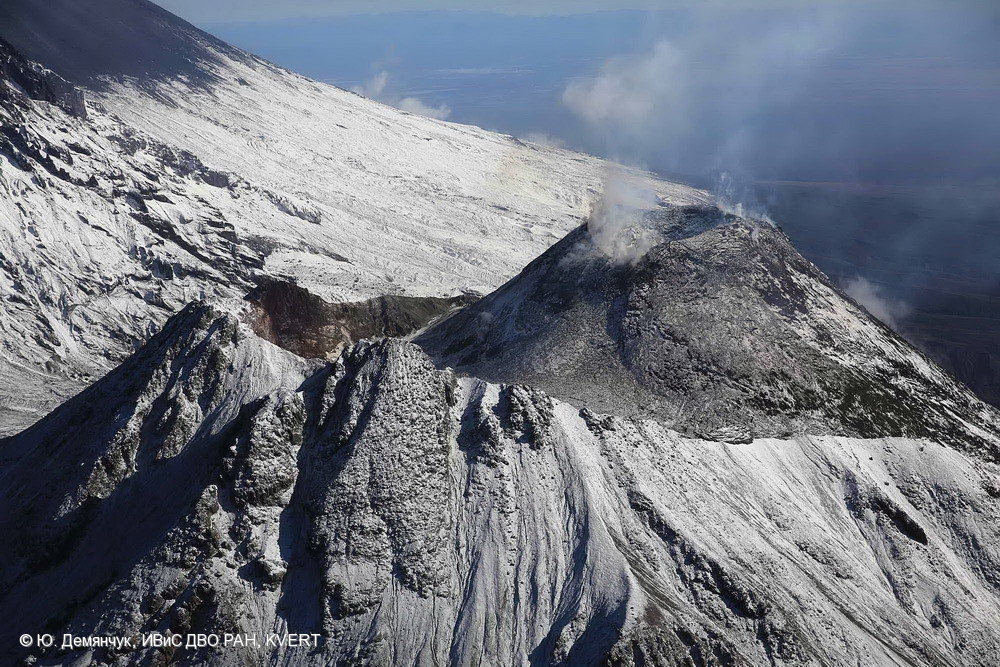 |
Figure 17. View of the summit showing fumarolic activity at Bezymianny on 16 September 2014. Photo by Yu. Demyanchuk; courtesy of IVS FEB RAS, KVERT. |
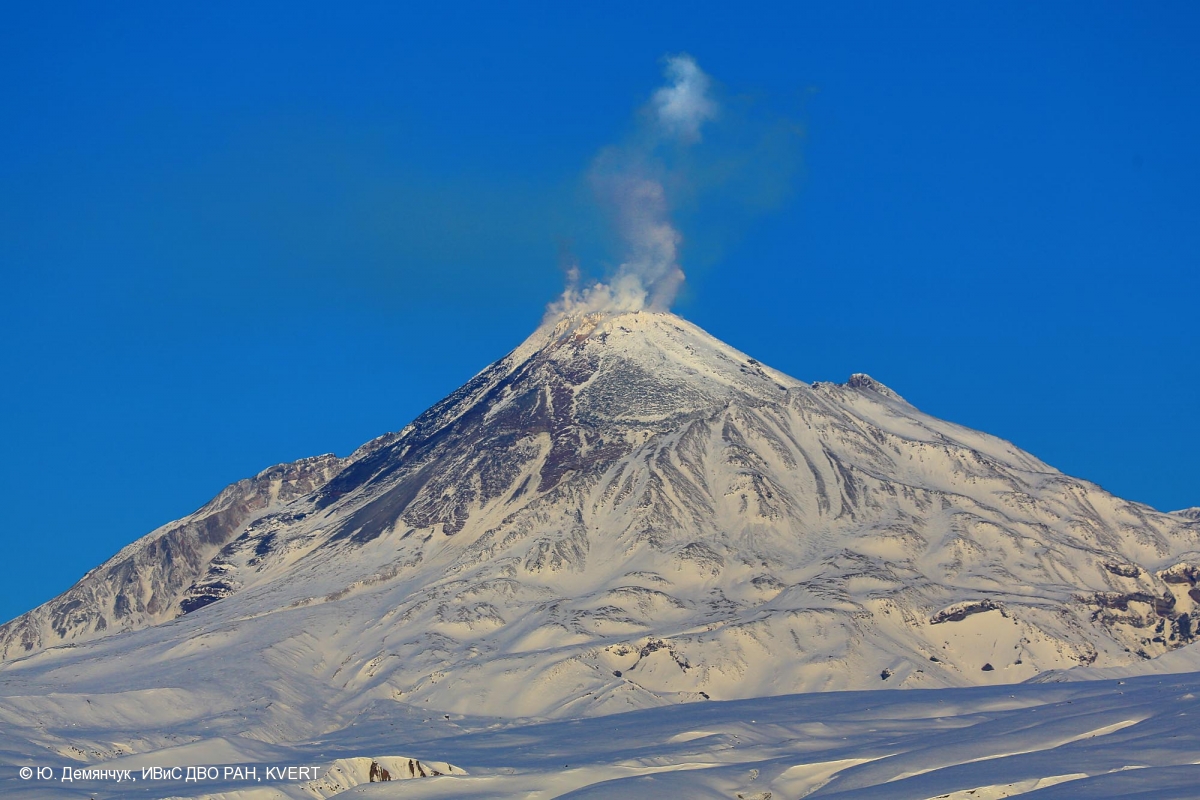 |
Figure 18. Moderate gas-and-steam activity at Bezymianny on 15 April 2015. Photo by Yu. Demyanchuk; courtesy of IVS FEB RAS, KVERT. |
Activity during 2016. KVERT reported that weak volcanic activity continued into January 2016, with moderate gas-and-steam activity through 12 December 2016. During this time, satellite data by KVERT showed a weak thermal anomaly over the volcano on most days, although on some days KVERT described the volcano as "quiet." Often the volcano was obscured by clouds.
The Tokyo VAAC reported that on 30 July an ash plume rose to an altitude of 3 km and drifted E, an observation based on information from the Yelizovo Airport (UHPP). Weak fumarolic activity continued in late August (figure 19).
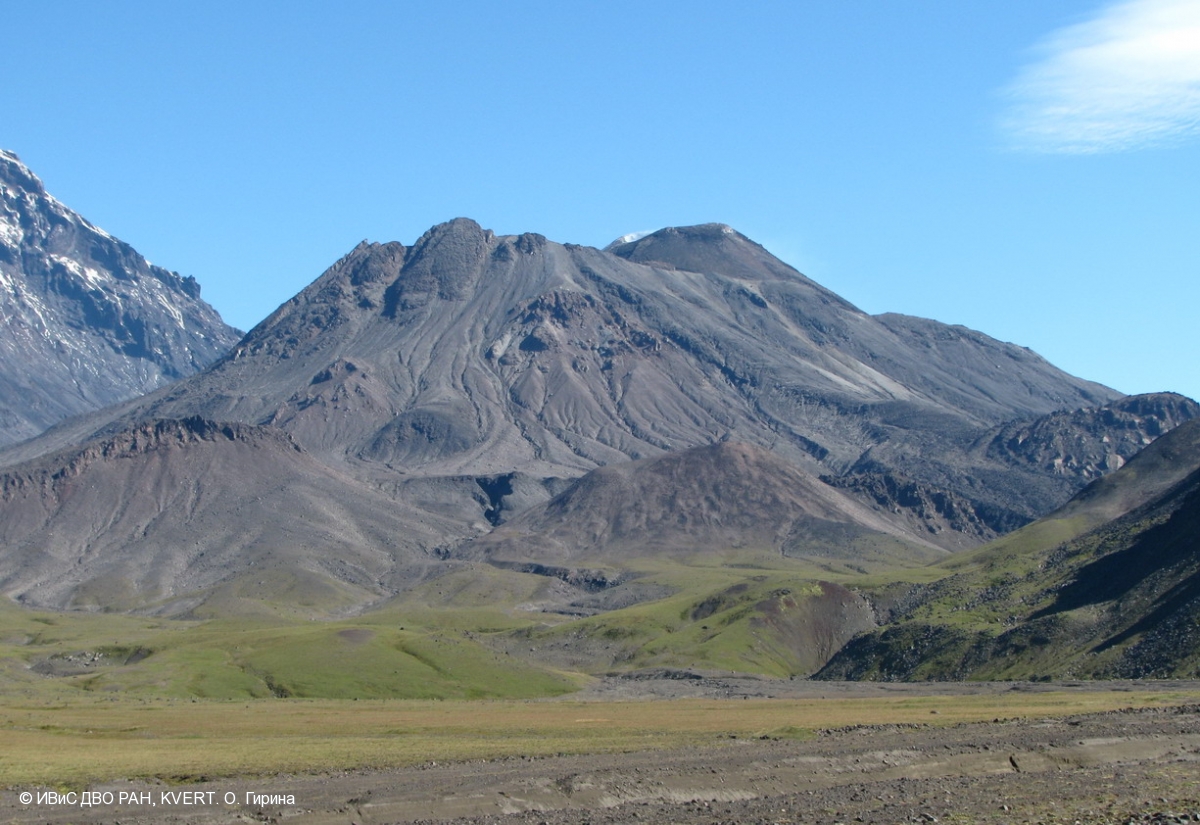 |
Figure 19. A small, weak, fumarolic plume could be seen rising from Bezymianny on 24 August 2016. Photo by O. Girina; courtesy of IVS FEB RAS, KVERT. |
Based on KB GS RAS (Kamchatka Branch of Geophysical Services, Russian Academy of Sciences) data, KVERT noted that seismicity began to increase on 18 November. The thermal anomaly temperature detected in satellite images also increased on 5 December, and then significantly increased on 13 December, probably caused by lava-dome extrusion. This activity prompted KVERT to raise the Aviation Color Code from Yellow, where it had been since 17 July 2014, to Orange (second highest level).
According to KVERT, a gas-and-steam plume containing a small amount of ash drifted about 118 km W on 15 December. The Tokyo VAAC noted that ash plumes rose as high as 6.1 km that same day. KVERT reported strong gas-and-steam emissions during 16-31 December (figure 20); a gas-and-steam plume drifted about 60 km SW on 18 December. A daily thermal anomaly was detected over the volcano.
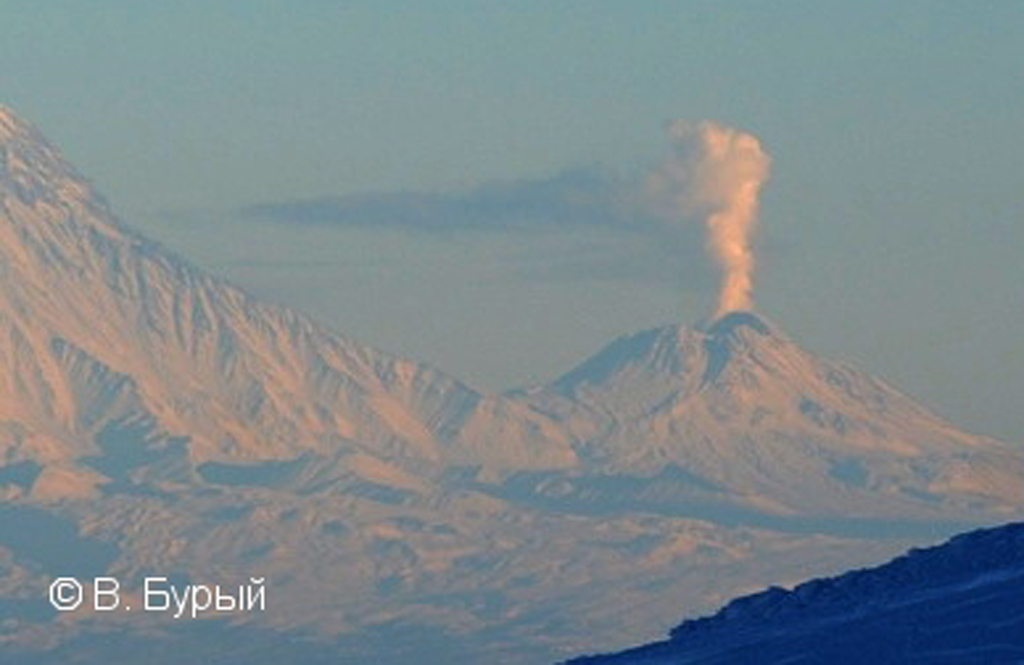 |
Figure 20. A strong gas-and-steam plume was seen rising from Bezymianny on 19 December 2016. Photo by V. Buryi; courtesy of IVS FEB RAS, KVERT. |
Activity during January-May 2017. According to KVERT, lava-dome extrusion likely continued into January 2017. Strong gas-and-steam emissions continued through 19 January 2017 and a thermal anomaly was detected over the volcano during most days. On 12 January, KVERT noted that activity had gradually decreased after an intensification during 5-24 December 2016, and thus the Aviation Color Code was lowered to Yellow. Thereafter, KVERT characterized the volcano as having moderate gas-steam activity. On 23 February, KVERT reported that the effusive eruption continued and that lava was flowing on the S flank of the lava dome.
On 9 March at about 1330, an explosive eruption occurred (figure 21). Based on webcam observations, at 1454 an ash plume rose to altitudes of 6-7 km and drifted 20 km NE. The Aviation Color Code was raised to Orange. About 30 minutes later, at 1523, an ash plume rose to altitudes of 7-8 km and drifted 60 km NW. KVERT raised the Aviation Color Code to Red, the highest level. Satellite data showed a 14-km-wide ash plume drifting 112 km NW at an altitude of 7 km. Later that day a 274-km-long ash plume identified in satellite images drifted NW at altitudes of 4-4.5 km; the majority of the leading part of the plume contained a significant amount of ash. Lava flowed down the NW part of the lava dome. The Aviation Color Code was lowered to Orange. Ash plumes drifted as far as 500 km NW.
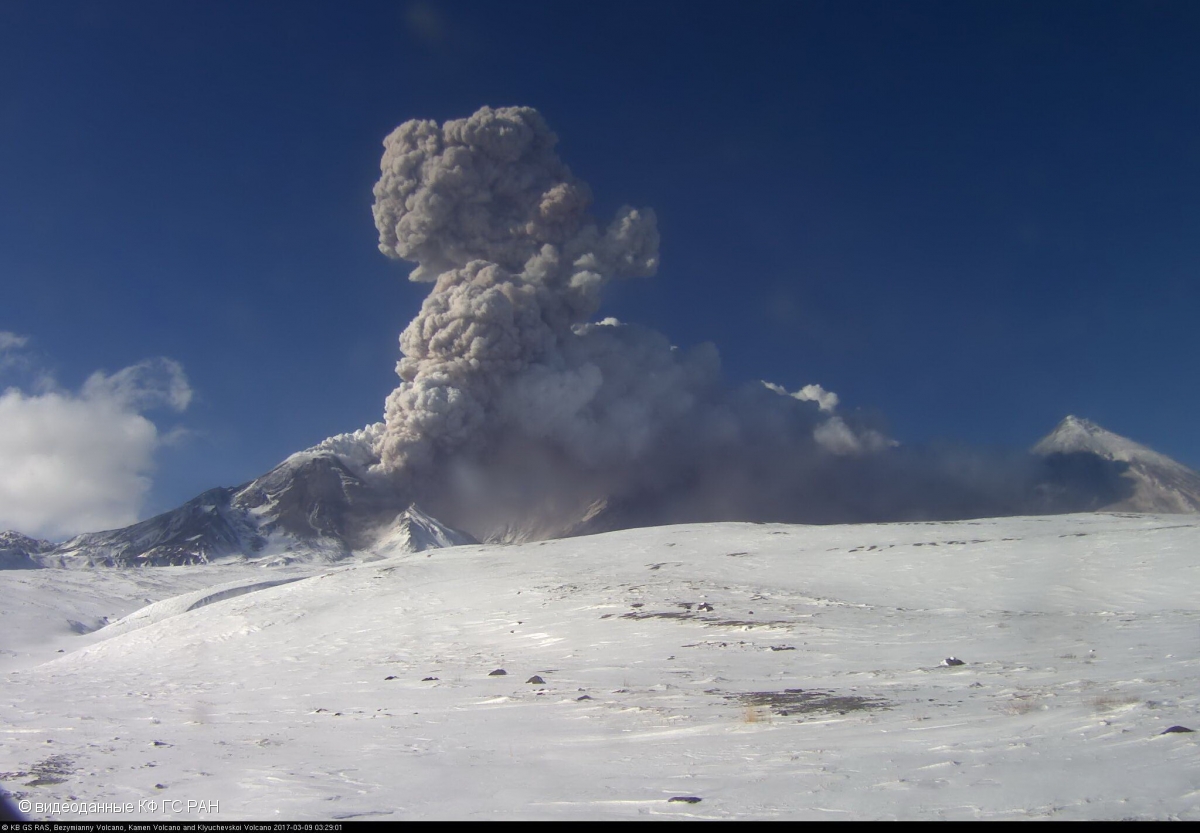 |
Figure 21. The start of an explosive eruption from Bezymianny was captured in this image taken from a webcam video on 9 March 2017. Video from KB GS RAS; courtesy of IVS FEB RAS, KVERT. |
KVERT reported that lava continued to advance down the NW flank of the lava dome during 10 March-21 April, and gas-and-steam plumes rose from the crater. A thermal anomaly was visible most days in satellite images. The Aviation Color Code was lowered to Yellow on 25 May. According to a KVERT report on 26 May, the volcano became quiet after the 9 March episode, although strong gas-and-steam emissions and daily thermal anomalies continued.
Thermal anomalies. Thermal anomalies, based on MODIS satellite instruments analyzed using the MODVOLC algorithm, were almost daily events during January through 2 November 2016, except none were reported in March through 19 May 2016. On many days, multiple pixels were reported (13 pixels on 1 September). The number of events diminished in December (only six days), and except for a brief period during 9-12 March 2017, none were reported after 20 December through at least 26 May 2017.
The Mirova (Middle InfraRed Observation of Volcanic Activity) volcano hotspot detection system, also based on analysis of MODIS data, reported several hotspots each month during May-August 2016, with a significant increase in September through early November (figure 22). Numerous hotspots were again reported in December, but only a few in January and February, except for a narrow cluster during the middle of February. In contrast to the MODIS/MODVOLC data, numerous hotspots were reported in March, April, and May 2017. The vast majority of hotspots during the past 12 months were within 5 km of the volcano and were of low power.
Geological Summary. The modern Bezymianny, much smaller than its massive neighbors Kamen and Kliuchevskoi on the Kamchatka Peninsula, was formed about 4,700 years ago over a late-Pleistocene lava-dome complex and an edifice built about 11,000-7,000 years ago. Three periods of intensified activity have occurred during the past 3,000 years. The latest period, which was preceded by a 1,000-year quiescence, began with the dramatic 1955-56 eruption. This eruption, similar to that of St. Helens in 1980, produced a large open crater that was formed by collapse of the summit and an associated lateral blast. Subsequent episodic but ongoing lava-dome growth, accompanied by intermittent explosive activity and pyroclastic flows, has largely filled the 1956 crater.
Information Contacts: Kamchatka Volcanic Eruptions Response Team (KVERT), Far Eastern Branch, Russian Academy of Sciences, 9 Piip Blvd., Petropavlovsk-Kamchatsky, 683006, Russia (URL: http://www.kscnet.ru/ivs/kvert/); Institute of Volcanology and Seismology, Far Eastern Branch, Russian Academy of Sciences (IVS FEB RAS), 9 Piip Blvd., Petropavlovsk-Kamchatsky 683006, Russia (URL: http://www.kscnet.ru/ivs/eng/); Kamchatka Branch of the Geophysical Service, Russian Academy of Sciences (KB GS RAS) (URL: http://www.emsd.ru/); Tokyo Volcanic Ash Advisory Center (VAAC), 1-3-4 Otemachi, Chiyoda-ku, Tokyo, Japan (URL: http://ds.data.jma.go.jp/svd/vaac/data/); Hawai'i Institute of Geophysics and Planetology (HIGP) - MODVOLC Thermal Alerts System, School of Ocean and Earth Science and Technology (SOEST), Univ. of Hawai'i, 2525 Correa Road, Honolulu, HI 96822, USA (URL: http://modis.higp.hawaii.edu/); MIROVA (Middle InfraRed Observation of Volcanic Activity), a collaborative project between the Universities of Turin and Florence (Italy) supported by the Centre for Volcanic Risk of the Italian Civil Protection Department (URL: http://www.mirovaweb.it/).


